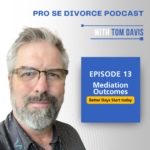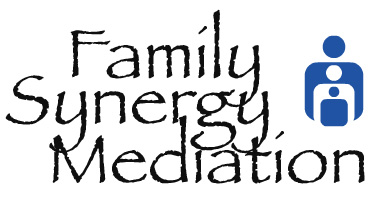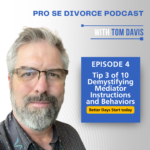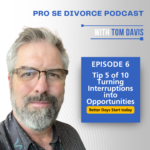
Episode Summary:
In Episode 13, Tom Davis explores the diverse outcomes that mediation can yield beyond simple “success” or “failure.” Through practical examples and real cases, Tom highlights how a session without any formal agreement can still create value for the parties involved. He explains that sometimes the value of mediation lies in laying groundwork, clarifying key issues, or even giving the couple insight into their relationship dynamics.
Listeners will gain a deeper understanding of why mediation outcomes aren’t strictly defined by resolved or unresolved issues and how the process can still bring significant, often unexpected, benefits. Whether you’re preparing for a mediation or want to learn about alternative dispute resolution, this episode offers valuable insights into maximizing outcomes from the process.
Key Takeaways:
- Common Mediation Outcomes
- All Issues Agreed To: An ideal resolution where both parties agree on all discussed topics, leading to a finalized agreement.
- Some Issues Agreed To: Known as partial success, this outcome allows the parties to focus on unresolved issues later or with additional support while preserving agreements on other points.
- Held Over: Mediation is paused due to time constraints or to gather more information, with plans to resume. Keeping dialogue open in these cases can prevent costly litigation and foster constructive discussion.
- No Issues Resolved: While it may appear unproductive, this outcome can help frame issues more clearly, providing essential context for any future litigation or mediation sessions.
- No Show: Particularly relevant for court-ordered mediation, a party’s absence can impact the mediation’s official status and may lead to court-imposed consequences.
- Unsuccessful or Successful: Success isn’t solely defined by agreement; Tom discusses how “success” can also mean identifying alternative ways forward, uncovering misunderstandings, or determining mediation’s feasibility.
- Court-Ordered Mediation Essentials
- Understanding Court Orders: Tom explains the importance of carefully reviewing court mandates, as they often specify mediator selection, deadlines, and topics to address. Failing to adhere to these orders can complicate the process.
- Compliance and Documentation: Properly reporting the mediation’s status (full, partial, no agreement) is crucial. Tom discusses how court documents, such as certificates of compliance, formalize mediation outcomes and ensure they’re recognized in legal proceedings.
- Alternative Mediation Outcomes
- Cancelled Mediation: In some cases, the parties may find resolution independently before or during the mediation. Tom shares insights on how avoiding formal mediation can be mutually beneficial when agreements are reached on one’s own terms.
- Partial Agreements with External Support: When unresolved issues need third-party input (e.g., valuation experts for financial disputes), mediation can allow certain topics to be decided separately without reopening entire agreements.
- Framing Core Issues: Mediation often brings underlying issues to the surface—like emotional concerns masked as financial demands—helping parties better understand their true positions. Tom shares examples of how these insights can save time and money by clarifying what’s really at stake.
- Financial Discovery: Even if no agreements are reached, the financial disclosures required in mediation can serve as a cost-effective foundation for future negotiations, whether in continued mediation or court proceedings.
- Creative Uses of Mediation
- Non-Traditional Family Dynamics: Mediation can involve extended parties, such as significant others or family members, to address broader issues affecting parenting or spousal arrangements. For example, including a step-parent in a session can address tension directly, resulting in a more holistic solution.
- Assessing Case Viability: Sometimes mediation is a stepping stone for deciding on the best dispute resolution approach. Tom describes cases where mediation helped the parties determine that another path, like arbitration or litigation, was more appropriate.
- Decision-Making Approaches: In complex financial or high-stakes situations, mediation can be used to set guidelines for selecting the best dispute resolution method before diving into specific agreements.
Final Thoughts:
Tom underscores the value of remaining open-minded about mediation outcomes. By focusing on realistic and varied goals, mediation can yield meaningful insights even if a full agreement isn’t reached. These creative approaches and non-traditional outcomes help parties preserve valuable groundwork and move forward with confidence—whether that means building on partial agreements, pursuing other solutions, or simply gaining better insight into the issues at hand.
Next Episode Teaser:
In the next episode, Tom will discuss three primary types of co-parenting after divorce, offering guidance on identifying the right approach for you and your co-parent. Understanding and aligning on your co-parenting style is essential to creating a successful parenting plan and avoiding prolonged conflict.
Duration:24:15
Size:12.6MB
Episode:2024-13
Key Links:
- Learn More about Family Synergy Mediation here: https://myfamilymediation.com
- Subscribe for future content here: https://myfamilymediation.com/newsletter/
- Explore more episodes here: https://myfamilymediation.com/podcasts/pro-se-divorce-podcast/
- On Spotify here: https://open.spotify.com/show/48W4evUkM5kqxAT73LrRsY?si=18999b16ef984434
- On Apple Podcasts here: https://podcasts.apple.com/us/podcast/divorce-mediation-journal/id1763072291
- On Youtube Podcasts here: https://youtube.com/playlist?list=PL2ZxaROT6CGnwzRp0BDPyDG45J_JcYDJv&si=dRUBe7pCM7A4tdSd










